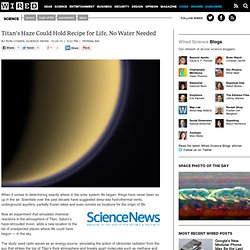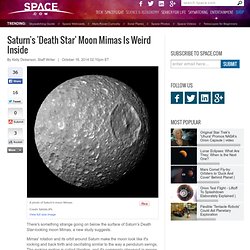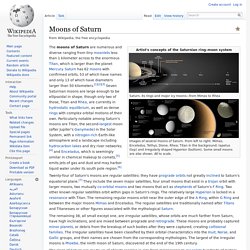

Microbes on or within Saturn's moon Enceladus? Microbes on Enceladus?

There’s a chance that Saturn’s sixth-largest moon, Enceladus, might harbor microbial life according to scientists studying information obtained by NASA’s Cassini spacecraft. The spacecraft is now making a series of tantalizingly close flybys to the moon, scientists said on March 27, 2012. They said watery jets erupting from Enceladus might be coming from a vast underground sea. Saturn Moon Has Oxygen Atmosphere. An oxygen atmosphere has been found on Saturn's second largest moon, Rhea, astronomers announced Thursday—but don't hold your breath for colonization opportunities. For one thing, the 932-mile-wide (1,500-kilometer-wide), ice-covered moon is more than 932 million miles (1.5 billion kilometers) from Earth.
For another, the average surface temperature is -292 degrees Fahrenheit (-180 degrees Celsius). And at less than 62 miles (100 kilometers) thick, the newfound oxygen layer is so thin that, at Earthlike temperatures and pressure, Rhea's entire atmosphere would fit in a single midsize building. Still, the discovery implies that worlds with oxygen-filled air may not be so unusual in the cosmos. (Related: "Potentially Habitable Planets Are Common, Study Says. ") At about 327,000 miles (527,000 kilometers) from Saturn, Rhea orbits inside the planet's magnetic field. Knowing where and how oxygen exists in the universe may in turn help scientists plan future robotic and manned missions. River Networks On Titan Point To Puzzling Geologic History Eurasia Review. By Eurasia Review For many years, Titan’s thick, methane- and nitrogen-rich atmosphere kept astronomers from seeing what lies beneath. Saturn’s largest moon appeared through telescopes as a hazy orange orb, in contrast to other heavily cratered moons in the solar system.
In 2004, the Cassini-Huygens spacecraft — a probe that flies by Titan as it orbits Saturn — penetrated Titan’s haze, providing scientists with their first detailed images of the surface. Radar images revealed an icy terrain carved out over millions of years by rivers of liquid methane, similar to how rivers of water have etched into Earth’s rocky continents. While images of Titan have revealed its present landscape, very little is known about its geologic past. “It’s a surface that should have eroded much more than what we’re seeing, if the river networks have been active for a long time,” says Taylor Perron, the Cecil and Ida Green Assistant Professor of Geology at MIT.
What accounts for a low crater count? Titan’s Haze Could Hold Recipe for Life, No Water Needed. When it comes to determining exactly where in the solar system life began, things have never been so up in the air.

Scientists over the past decade have suggested deep-sea hydrothermal vents, underground aquifers, partially frozen lakes and even comets as locations for the origin of life. Now an experiment that simulates chemical reactions in the atmosphere of Titan, Saturn’s haze-shrouded moon, adds a new location to the list of unexpected places where life could have begun — in the sky.
The study used radio waves as an energy source, simulating the action of ultraviolet radiation from the sun that strikes the top of Titan’s thick atmosphere and breaks apart molecules such as methane and molecular nitrogen. The experiment is the first to produce amino acids and the nucleotide bases that make up DNA and RNA — the basic ingredients of life — without the need for liquid water, says Sarah Hörst of the University of Arizona in Tucson. Titan. Strongest evidence yet indicates Enceladus hiding saltwater ocean. This image shows icy spray spewing from Saturn's moon, Enceladus. Credit: NASA/JPL/Space Science Institute The new discovery was made during the Cassini-Huygens mission to Saturn , a collaboration of NASA, the European Space Agency and the Italian Space Agency. Launched in 1997, the mission spacecraft arrived at the Saturn system in 2004 and has been touring the giant ringed planet and its vast moon system ever since. Saturn's 'Death Star' Moon Mimas Is Weird Inside.
There's something strange going on below the surface of Saturn's Death Star-looking moon Mimas, a new study suggests.

Mimas' rotation and its orbit around Saturn make the moon look like it's rocking and back forth and oscillating similar to the way a pendulum swings. The rocking motion is called libration, and it's commonly observed in moons that are influenced by the gravity from neighboring planets. However, using images of the moon captured by the Cassini spacecraft, Radwan Tajeddine, a research associate at Cornell University, discovered that the satellite's libration was much more exaggerated in one spot than predicted.
Heexpects it must be caused by the moon's weird interior. "We're very excited about this measurement because it may indicate much about the satellite's insides," Tajeddine said in a statement. Feel the libration Astronomers have long been using the rotation and orbit of celestial bodies to guess what their interiors might be like. 0 of 10 questions complete. Moons of Saturn. Artist's concepts of the Saturnian ring–moon system Saturn, its rings and major icy moons—from Mimas to Rhea Images of several moons of Saturn.

From left to right: Mimas, Enceladus, Tethys, Dione, Rhea; Titan in the background; Iapetus (top) and irregularly shaped Hyperion (bottom).